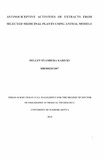| dc.description.abstract | This study reports the findings of the scientific evaluation of selected indigenous plants used by Kenyan communities for the management of pain and painful conditions.
Pain is associated with high morbidity and socioeconomic burden. It is the key symptom for the diagnosis of several disease conditions and is widely accepted as one of the most
important determinants of quality of life.
Plants have been claimed to have analgesic or antinociceptive effects by several communities in East Africa and a great number of people use plants for management of painful conditions. Nine plants namely, Toddalia asiatica, Senna singueana, Rhus natalensis, Teclea simplicifolia, Clausena anisata, Warburgia ugandensis, Sapium ellipticum, Albizia anthelmintica and Psiadia punctulata were assessed for antinociceptive properties using standard nociception animal models that target thermal and chemical stimuli. All the test mice used in the study were initially assessed for quality neurological and motor function. The selected mice were used to assess the sensorimotor effects of the nine plants at dose 200 and 100 mg I kg. Albizia anthelmintica and Psiadia punctulata induced impaired motor coordination in mice at the tested doses and therefore were disqualified for further investigations. Assessment of the central nociception effects of the remaining seven plants using the tail flick test, confirmed signi ficant antinociceptive effects of root extracts of Toddalia asiatica (p < 0.001), Senna singueana (p < 0.05) and Rhus natalensis ( p < 0.01 )at dose 200mg I kg. Only T.asiatica exhibited significant (p < 0.01) effect at lQOmgI kg dose compared to the negative controls.
Further tests using the hot plate assay (thermal stimuli) and the acetic acid induced writhing test (chemical stimuli) confirmed T. asiatica root extract as having superior anti nociceptive affects compared to the other plants. T. asiatica was also found to have antinociceptive effects in pain caused by inflammatory chemicals using the formalin test.
Isolation of compounds from the root extract of T. asiatica yielded seven compounds, four
alkaloids and three coumarins that were further characterized by NMR. The coumarins,
Isopimpinellin and 6-(3-methylbut-2enyloxy)-8-methoxy2h-chromen-2-one did not induce
any significant antinociceptive activity in the tail flick assay while 6, 7-dimethoxy-5- (3methyl-2-oxobutyl)-2H-chromen-2-one, 8-Acetonyldihydrochelerythrine and 6-(2, 3dihydroxy-3-methylbutyl)-5,7-dimethoxy-2H-chromen-2-one)
induced significant (p < 0.05) antinociceptive effect compared to the negative controls. The alkaloids, 8-oxochelerythrine and dihydrochlerythrine exhibited significant (p < 0.001) antinociceptive effects with dihydrochlerythrine showing the highest activity.
Dihydrochlerythrine was isolated from the root extract of T. asiatica and assayed for
antinociception for the first time in this study. More antinociceptive tests need to be done to ascertain the antinociceptive activities in chronic pain models as well comparative studies with standard analgesic drugs. Safety screening of the crude extract as well as of the isolated compounds is also recommended.
This study authenticated the analgesic use of the root extracts of T. asiatica for the
management of pain and hence supports the folklore use of the herb.
Key words: Antinociception, Toddalia asiatica, mice, alkaloid, dihydrochlerythrine | en_US |


